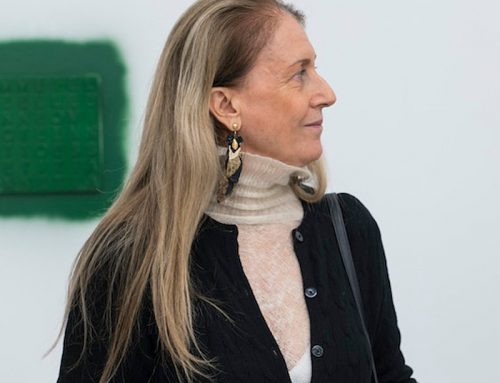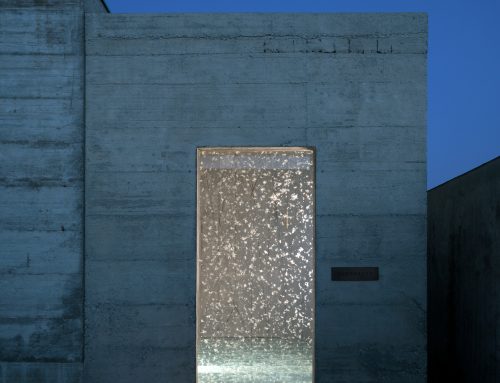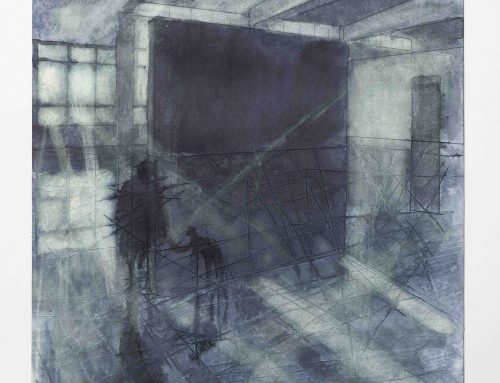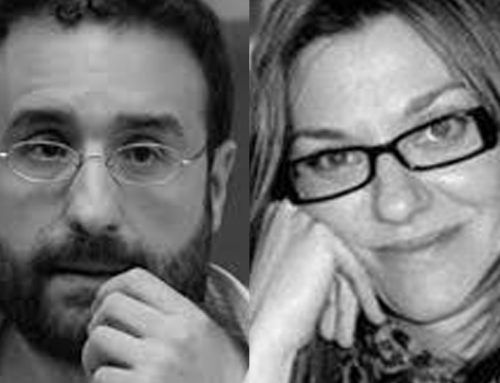The two levels, one below and one above, lead me to think of El Greco
Above, the angels, incarnate beings, without gravity, represented alone or in groups in one part or another of the canvas, moved by a cabalistic logic. They don’t speak. No-one has ever depicted them as being sad, but they are not happy either. They don’t fall in love and they never die, They are protected by their Creator as long as they never put their feet on the ground. Below, small and large circles of coloured glass which fill what remains of the architectural design of the floor once you remove the staircase and the facilities. Above them the people: those that come from the underground with their coats and hats; women from the neighbourhood with their shopping bags, blond or black hair blowing in the wind, wearing elegant blouses and vermillion, sun yellow, tropical tree green, Sienna earth brown or darkness black coloured shoes; a child or two; one or two husbands. They come and go, climbing the stairs to see the paintings while engrossed in discussion. Then they go down again and cross the circles territory. They go into the street where the old barracks were and while they discuss get lost in the urban environment of Rome. But in the museum, the circles of various dimensions, with the pale colours of glossy magazines from the 50s, remain in their cheerful immobility even after closing time.
Jannis Kounellis, Artist
Melanges
The work that Afredo Pirri proposes for the space situated in the foyer of the Contemporary Art Centre in Rome, which was created by Zaha Hadid, is the result of the artist’s past experiences. By intervening in historically and artistically emblematic spaces with an installation of vast, mirror surfaces, which can be walked on, Pirri explores the iconic potential of overturning or constructing an image, by using the resources offered by the constructed space while at the same time provoking its progressive destruction.
His installations are metaphorical works, which are able to stimulate a different perception of the three-dimensional, sensorial experience of architectural spaces while playing on the subtle relationship between art and architecture, the unity and fragmentation of the image and of space. This assumption is particularly significant if a dialogue is to be established between his work and Zaha Hadid’s compositional approach, which involves the difficult task of analysis, deconstruction and re-composition of the elements to generate the architectural container. The entrance foyer, which is the key area of the museum as conceived by Hadid, is strongly characterised by a dynamic, vertical element and by the staircase crossing it, thus emphasising the compression and dilating mechanisms in the perception of the space which is destined to receive and lead the flow of visitors from exterior to the interior and vice versa. Rather than installing a final work by an “artist”, which would be defined by the space and be identifiable, Pirri proposes an intervention which interacts with the floor of the foyer itself and, as a consequence, with the whole construction. Focusing the attention on the horizontal surface which is being walked on means challenging the figurative and spacial element which is dominant in Italian painting, town planning and architectural tradition. In Pirri’s work this element is taken, renewed and transformed so that the “decoration” is not superimposed on the architectural space but is made to interact with it, consciously influencing the perception of the transition between the city and the museum and between the realm of reality and that of art. This brings to mind the “internal” perspectives seen in houses as well as cities where shiny, inlaid, marble floors act as precious bases and anchorage for scenes and characters which are rich in symbolic references and are collocated in a natural or artistic context. The patient work needed by the will to transform a conceptual provocation into an element which can be used on a daily basis and for public use can be identified with the evolution which took place between the first and the second phase of Pirri’s proposal for the installation. On closer analysis, the process of adapting the original idea of the work to the challenge of giving it a real function within the confines given by the nature of Hadid’s architectural space is a constant characteristic feature of Pirri’s artistic work, which is always characterized by the crossover that exists between the disciplines of art and architecture. The simple, uniform, mirrored surface, which is at the same time fragile and emanates sound, evolves into an elaborate “carpet-like” composition. Small mirror fragments are incorporated into inlaid pieces of resistant, specially-treated glass by a dense, slightly milky substance to form round perimeters of various dimensions. These are alternated by interstitial areas which create a cheerful surface of many colours for everyday use, which may not necessarily be perceived as a work of art but will become part of the architectural context. In the space overhead, coloured “trapezes” hanging at various heights establish a subtle communication with the circular, mirror surfaces distributed on the floor. The reference to the world of the circus and in particular to the spectacular lightness of its aerial and balance performances are not a novelty in the context of creativity. It suffices to recall the admiration Charles and Ray Eames had for circus art because it exemplified the perfection which can be obtained not only by hard work but by making it seem effortless. Fundamentally, this is a characteristic which is required of any work of art and with which Pirri is in full agreement. The meaning the metaphor of the circus has in art, life, architecture or the museum institution itself, be it positive or negative, is left to the individual interpretation. The two distinct and complementary proposals made by Pirri therefore tend to go beyond the confines of a finite work, in order to interact with the architectural space at its disposal, thus offering the spectators another level of interpretation of the experience they are about to venture into.
Arch. Federica Zanco, director of Barragan Foundation, Basilea
Maxims for a Museum of the XXI Century
Nothing more than entering the MAXXI’s atrium that we feel suspended, in absence of gravity, as if we were lifted from the same floor we are stepping onto. We perceive ourselves in a warm place, full of inert memory, and in a frigid place, ready for analysis and novelty. I recognize myself from the greatness that acquires my conscience (I’m light without shadow) knowing myself in the midst of infinite complexity, because the building’s architectural angles place me in a multiple-sided geometric figure. The ground being stepped is apparently fragile, slippery, but even so, I feel strong, entrenched. At the same time I catch an upwards projected energy, towards the abstract universe, through the mathematical numbers, the names of poetry, the notes of music and dance movements, and, in turn, touching the ground, I am rooted in the memory through history, myths, science and communication. Perhaps one of art’s qualities is to present knowledge and to represent memory, and this reflected act (of invention and relation) is higher due to the reflection (the critic, the mutation). Culture, art and science, take a fragile risk while proposing but consistent altogether.
This space, so full of sudden reflected and reflective images, makes me feel in a shared surface, where I am subject of community. Art is an act of blindness in its own empathizing and at the same time an act of visibility for the fact that a collectiveness is found altogether and singularly at admiring a unique art work. This atrium of the MAXXI generates maxims in me. Judgments will have to be inscribed in a public place with the writing of light, volatile reflections, invisibility that can be read by all in areas of internal connection. This place makes me participate in a sum of individual perceptions building a networked collective intelligence. The place, such as non-place, as a unique place, absorbs me making me exceed the strict border between watching, the construction of a look and the writing of a glance. I am honored as the visitor of this twenty-first century museum, that upon entry, it invites me to be a subject, to be an art work.
What is the difference between raising your eyes to the sky or to watch the ground? Our vision is made of the knowledge of those who have seen before us. And despite it, in this place of permutations, our vision will be inaugural. We know that in the Mediterranean, our ancient classic writers saw the land as the mirror of the sky and all that was happening there, was planned as simulacrums in the air. The Mediterranean culture created moral as a form of civilization. In the Orient, while some were faithfully reproducing some mathematical astronomy, others polished the sky until it turned into a mirror. Mystical abstraction or hyper reality. Later, in the Renaissance, the mirror bended and gods and souls started to come down to earth to humanize. Printing was what put at the same level the superior images with the receptive ones. With the Encyclopedia we had a horizontal spread of knowledge, rational, a universal ideal, revolutionary, as the sum of fragments. And when the philosopher-artist added uncertainty to the materialistic certainty, found himself alone, isolated, as a circus character passing through the public square on a suspended wire.
Arrived up to this point, today, with the transversal and interdisciplinary knowledge between Arts, Sciences and Communication never again will art merely be the mirror of the world. A redefinition of knowledge and the radiation of the invention, the ethics of participation and the aesthetics of freedom, we undertake in this Place and Non-Place, Place of Pleasure and of the Critical Knowledge, Place of the Subject and of the Collective Intelligence.
Alfredo Pirri, knows, as we know, the effort for and to live in the enigma. The fallen angel and the philosopher have precipitated, trapped on the ground, and have broken the big mirror, moment in which all the images of the history of representation have been scattered in small fragments until its disappearance. Art is born from deleting, in a tenacious will to start over, to dare to say again. The Museum, therefore, consolidates reality.
Behold the legend, dynamic and formal, of experience and ritual, through which Pirri invites us to enter: to reconstruct with the fallen and invisible images, absorbed by the mirror, a reflector and reflective space, of memory refusal and for the re-foundation of perception; a space for subjective discovery of the body in a collective work, social network; definitely, a place of places and an art of arts: an Art Museum for XXI century.
Vicenç Altaió, writer, essayist and director of Art Santa Mònica, Barcelona.
to see the project click here





